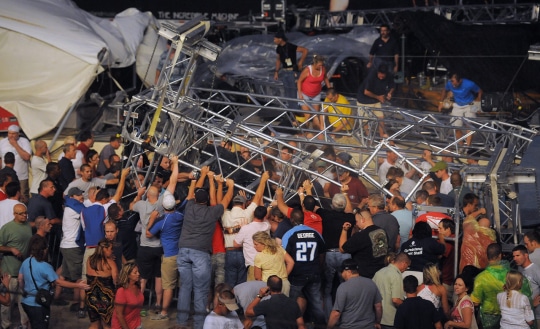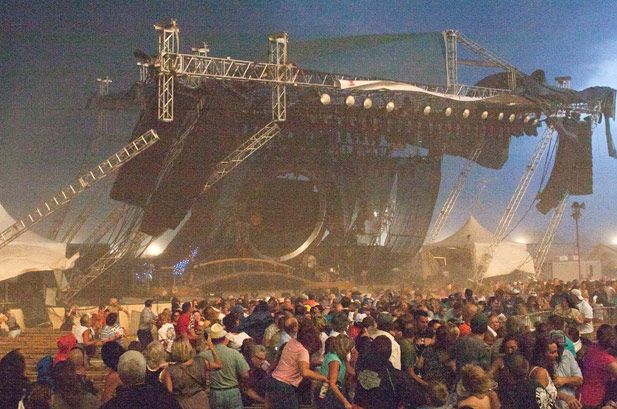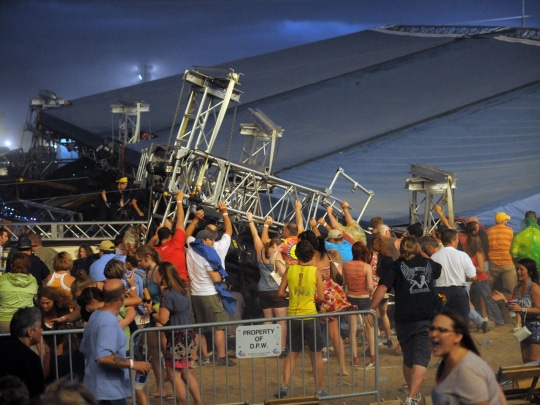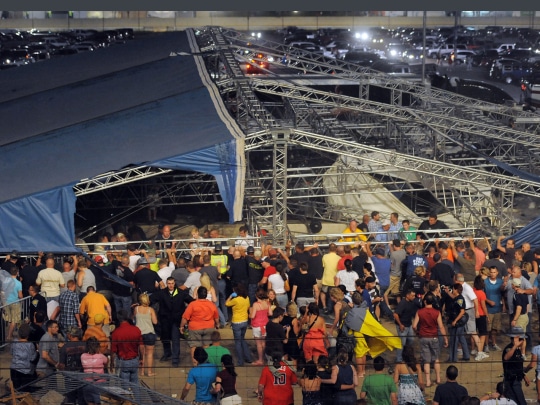
Sorry folks, this video is the harsh reality of what happened in Indiana on Saturday at the Sugarland concert. Just be forewarned, it shows the rig collapsing onto people, and it’s pretty real. What cannot, cannot, cannot be overlooked at the end of the video is the bunch of hands that came running to lift that structure, regardless of whether or not they could.
This made me cry, I am dead serious. We lost a member of the local crew of IATSE Local 30 in this disaster, too. Brother, rest in peace. Nathan Byrd, also apparently known as “Save The Show” Nathan, leaves behind two teenagers. Nathan was in the truss at the time of its collapse. The gear belongs to Mid-America Sound out of Greenfield, Indiana. If you’ve done corporate or concerts in the midwest, chances are you’ve probably run into their gear, that’re a widely used production company. Mid America Sound is also one of the most reputable companies around that area; you don’t get gigs like this without being a top player, and they are a top player. Commentary into them being at fault here should get shunned.
Four people and one stagehand are dead and at least forty others are injured because something our industry put together to have a show collapsed in weather. What happened? Is this weather? Were all of the proper safety features installed properly and working? I’m not placing blame, that’s not even remotely the point right now. The point is that this has happened, it seems to be happening a fair amount lately in roughly this size of production, and now what are we going to do to mitigate this from happening? I have heard more than one person after these events say something along the lines of “it happens, thank God no one was hurt” or “it happens, these people were just unlucky.”
Bullsh*t.
Also, Governor Daniels, STOP SAYING that this was “a freakish accident,” because that is a lie. This could have been avoided if your promoters would have had a bit more importance placed on concertgoer safety. This should have been shut down until the weather passed, or shut down altogether WAY in advance of the ten minutes you people have been reporting as the only warning you had for this wind event. Stop diluting this by calling it a freakish accident. It’s further from the truth than anything else you’ve said about the collapse.
I had to get ahold of my go-to safety guru, Erich Friend from Teqniqal Systems for this one, I’m no safety expert. Erich and I work together here and there on projects, but more than anything, Erich is a brilliant safety guy who writes for TheatreFace, has a safety and consulting firm, and writes the Theatre Safety Blog.
JimOnLight.com: Erich, you’re the best safety consultant I know, can you make some sense of this mess? What the hell is going on that this keeps happening? Indiana State Fair’s roof structure, the collapse in July at the Cheap Trick show in Toronto, Peter Frampton in Germany last year, what on earth is going on?
Erich Friend: Jim, you just touched the surface on the number of well documented events like this that have happened. In fact, this is the third one in three weeks. This most recent event is the most tragic in terms of body count – 45 injured, five dead — and is certainly one of the most visible due to the press coverage.
JOL: I think there are fingers to point here, but right now what is most important is to be solving the freaking problem. People died on Saturday. People died because an entertainment structure collapsed. Where do we go here? How do we stop this? Is ETCP the answer, or is there something else that we should be trying to implement or change?
EF: For starter’s, there will be a serious investigation of this by the Indiana State Police and OSHA to assess this event. Some of this will be a look at the structural integrity of the concert rig, some will look at the weather conditions, and another part will be to look at the venues’ management of the crowd and crew in clearing the area around the structure. Although the attachments for these structure may have been executed by ETCP certified riggers, this really only indicates that the connections may have been performed properly and that sufficient safety cables may have been attached to keep the lighting and sound equipment from separating from the canopy structure. The use of ETCP certified riggers may not have a large bearing on the structural decisions made during the design and set-up of the truss and support towers. Given the unique circumstances involved in outdoor events under portable canopies, there may be a clear need for ETCP to develop a third category of rigging certification that specifically addresses this segment of the entertainment industry.
JOL: There has to be blowbacks for this. Can you explain to a reader who doesn’t really understand what is going to now, what needs to happen because of this disaster? What ramifications will there be for this?
EF: With so many of these accidents happening recently, I would hope that the insurance carriers would begin to demand that a more robust system of structures, weather monitoring, fast track decision making authority, and crowd management planning be implemented. The structures that are used for these events certainly require closer scrutiny, as the covers for them act like huge sails in the wind and drag these canopies over too easily. This is an international problem, so to be effective, an international consortium of manufacturers’ designers, safety experts, meteorologists, and building code officials will have to ‘get on the same page’ so they can develop acceptable standards for the consideration of weather conditions. They will also have to develop clear criteria about when to ‘call a show’ and evacuate the venue. Apparently ‘common sense’ isn’t enough.
JOL: This is obviously not directly related to medium sized rigs like the one in Indiana – the U2 tower collapse, the Madonna collapse, obviously back in the day the monster Justin Timberlake/Christina Aguillera concert collapse in New Jersey come to mind as well as several others. Do you see this as impacting a certain size of production where safety is somehow lax or just non-existent? Make all of this make sense to me, I’ve never been on a show where anything drastic like this has happened. Is this the sheer force of nature, or something a little more deliberate?
EF: The Modonna tour stage canopy collapse and the Justin Timberlake/Christina Aguillera truss collapse were different than the weather related failures in that they were the outcome of equipment failures and failure to closely monitor rigging loads. Denial isn’t just a river in Egypt. The weather related collapses are strongly influenced by humans being in denial that the weather can bulldoze a stage structure in just seconds. Although there was only 10 minutes between the National Weather Service (NWS) issuance of a Severe Weather Warning and the collapse of the stage in Indiana, the weather front that triggered this warning was clearly visible and tracked for hours, if not days, in advance. When there are hundreds of thousands of pounds of equipment in the air over a stage, the potential for damage inside the ‘crash radius’ of the structure is significant. The structure must be assembled to minimize the surface area that the wind can blow upon (break-away canopy tarps, vent flaps, etc.) and the structure must be secured to withstand the forces expected to be imposed upon it under severe weather conditions. A proper weather emergency plan would have included the precaution of lowering the canopy to stage level, too, so that the wind could not exert forces near the top of the structure.
The shear force of nature is significant and should NEVER be underestimated. As mother nature would say (after she’s knocked back a few) “Don’t %$#@ with Mother Nature!” You can’t win. HUGE forces are involved. The key is that we KNOW this, therefore we can expect this. All the quotations you read and hear on the news after these tragedies that say “It just came out of nowhere”, “We just didn’t see it coming”, “We didn’t think it would get this bad”, or Indiana Governor Mitch Daniels saying “I’m not clear how anyone could have foreseen a sudden, highly localized blast of wind” are unbelievably ill thought-out statements. We have the technology to monitor wind and weather in real-time, we know how fast it is travelling, which way it is going, and where it is. What it takes is someone in a position of authority with enough common sense and large enough ‘nads to call the show and clear the venue will a sufficient margin of error to ensure that no one is put in harm’s way. The outdoor concert industry needs a serious reality check if they think that these accidents can be marked-up to voodoo weather or ‘freak’ occurrences. There was absolutely nothing about this that was unpredictable or unforeseeable. Like with most things, the body count has to get high enough to be noticed.
JOL: Thanks a lot, dude. This is a really bad situation from all angles. This is bad, very bad.
One begins to wonder when you work in this industry AND see something like this go down AND people lose their lives. I worked in a place once where a supervisor said to me – “we’ll get it fixed, but I think the funding will only arrive once someone falls out of the ceiling to show them it’s dangerous.” That kind of attitude makes me want to punch someone right in the mouth. What really sucks is that it’s probably closer to the truth than not. I think that there should be some serious ramifications to this horrific situation with respect to jail time and reprimand of a serious degree.
If you’ve not been following the news and you’re in the industry, well, that’s why I’m here, to help you with that. The frequency of these roof or stage collapses over the summer has not been ZERO where it should be; in fact, this makes THREE in the last three weeks. That is wholly unacceptable. This time, the little bit of comfort that these roof structures provide cost five people their lives, not to mention the trauma it doled out for others not killed in the collapse. I spoke with Scott Blair about this too – Scott used to work for High End Systems as the Director of Digital Light Development before BARCO decided otherwise. Scott’s also behind PlugFest, and does a ton fo work with Remote Device Management development. Scott’s a pretty vocal guy like I am, and he and I get along well in part due to that fact!
JimOnLight.com: Scott, what happened in Indianapolis? Don’t people follow the ANSI regulations with this kind of a scenario when people’s lives are at risk? There were several tens of thousands of pounds of gear hanging from that roof structure, where are the checks and balances?
Scott Blair: First off, let me state that I’m not an expert in rigging and I didn’t stay at a Holiday Inn Express last night either (http://www.youtube.com/watch?v=wm-h7YR_410). Most of my life has been spent on the Lighting side of the industry and in developing ANSI standards for control protocols. I spent a lot of my early formative years working on a Summer outdoor production in an area known for sudden and unpredictable wind and weather (and poor planning) which is where I gained a strong appreciation for what mother nature can dish out! With the disclaimers out of the way, what people need to realize is that while there are ANSI Standards for construction and use of portable stages developed by ESTA (now PLASA), but these are *voluntary* standards. There is no REQUIRMENT that anyone follow them and I see that as a serious issue. Reputable manufacturer’s (such as the one for this structure) are likely going to follow the standards out of good practice and common sense. Engineers from many of these manufacturer’s are typically the ones involved in writing them. There is a big disconnect when it comes to the guys out in the field erecting and using these stages though. The same goes for using ETCP certified riggers. Some venues may require them, but there are no government regulations I’m aware of anywhere that require this. One point I raised a couple years ago on this when discussing another one of these failures and what can be done to change the safety climate is that the Insurance carriers for all these outdoor stages and productions should be requiring that the standards are followed and certified riggers are used, in addition to requiring a Professional Engineer sign-off each time the stage is erected and failure to do so would void the insurance. In the absence of cohesive government regulations, the Insurance companies are in the best position to require and enforce the checks and balances occur. At the end of the day it is about the money with everyone, so the Insurance companies have a lot of pull. With the increasing number of failures in recent years, I hope that is something that may already be happening out there. Frankly, carnival rides get more scrutiny for safety than these large stages do and that is something that MUST change!
JOL: There are myriad issues with this entire horrific event that just need to be made outwardly obvious. Besides the obvious factor of an approaching major weather event, can you tell me what the most significant factors that could have been mitigated?
SB: There are lots! We’ve been discussing this a lot over at LightNetwork in the last 24 hours and sadly it took us as an industry stacking up bodies before people really take notice. Outdoor stage failures have become so commonplace in recent years that there isn’t even much reaction to them other than “Oh look, another one.” I said over 2 years ago it was only a matter of time before people started getting killed from these. Frankly, we’ve had an incredible run of luck that it took this long even though there were a lot of close calls. That is the FIRST thing that should have been noticed and mitigated! With the frequency of failures, no one thought it could happen to them and they’ve kept building these things bigger and adding more weight and more sails to them. Rather than being more cautious, it appears that the limits keep getting pushed farther! Everyone is trying to do their full arena show on an outdoor portable stage!
The SECOND and one of the most troublesome practices for me is the use of these tarp roofs and backdrops and side wind-walls. These all act as huge sails and exert ENORMOUS forces on a rig, particularly lateral forces where structures are the MOST vulnerable and where there is the most variability in terms of how the stage is erected with guy wires, ballast, and cross bracing to reduce them. Some of these roofs are designed for people to release them in high winds (i.e. cut away) and lots of speculation about how that could be made better and if the roof was cut loose sooner than this might not have happened. I see that discussion in the same vein as saying, ‘if the Titanic only had more buckets to bail water they would have been fine!’ I see all the tarp roofs and backdrops as serious safety factors. Even if in high winds you do manage to cut the roof tarp away before it brings the stage down, there is a serious amount of mass that and size that is now airborne and can likely kill or do serious harm wherever it lands! There are a lot people that believe cutting slits in the backdrops ‘allows the air to pass through.’ Yes, in very small quantities. A sail with holes in it is still a sail! I once worked with large 2 story store front set pieces that were constructed out of screen door material and scenic painted. Since it was fine mesh screen material the wind should just pass through them right? Wrong, these things made fantastic sails and more than one night the entire crew was trying to stop these things from blowing away.
Hanging PA also must stop. These things are enormously heavy, catch a lot of wind, and if not tied down will create a very nasty swinging wrecking ball. They also frequently prevent the roof from being lowered in bad weather, something that is a necessity.
The THIRD biggest issue appears to have been management. It is clear there was a serious lack of communication and decision making occurring there. The one thing I hear over and over in our industry is that people are too afraid to be the one that “cancelled the show” or being seen as crying wolf. Or even if they do try to make the call they are overruled by the Promoters. I sleep a lot better being unemployed or being disliked than I do being responsible for manslaughter. That’s what this is. It was not a freakish unforeseen weather event, it was a large storm line with hours of warning preceding it and no action taken to 1. actually evacuate people nearby, 2. lower the stage. 3. cut the roof free (at least not until way too late) or 4. even call the Spot Op’s down from the roof that should never have been up there to begin with! I don’t know how else to describe this gross negligence than being manslaughter. Besides being a well formed evacuation and weather plan for any outdoor event, there needs to be someone in charge that is fully empowered to overrule the money interests (Promoters/Band) and pull the plug. Furthermore, they need to be held legally responsible for doing that! So that the failure not to act has legal liability attached to it! When it is their ass on the line they won’t be as quick to defer to the Promoter or other money interests and they will be doing what is safest.
JOL: Why is it, do you think, that a decision to evacuate was made so late in the process? That is one thing that I just cannot quite wrap my head around – with a rig that large on a standing superstructure roof (and a BIG roof at that) and with such a front approaching that there were stagehands inside the roof structure at all? Why did they wait so long?
SB: No one wants to be the one to cancel the show (and also be responsible for refunding the money!) The natural reaction is to wait just a -little- bit longer to see if maybe it won’t be that bad. There was a wealth of information staring them in the face not the least of which is weather alerts of the National Weather Service of a severe storm line baring down on them. (See www.controlgeek.net for the weather analysis). Anyone who watches a thunderstorm roll-in knows that just because it is fairly calm right now doesn’t mean that in less than 5 minutes you won’t be getting the crap beat out of you by the winds and rain! I’ve seen several reports that the authorities made the decision to cancel but a minute or two later an announcer said they hoped to continue the show shortly. They were alerted where to go if an evacuation was called, but it was never called. The people who were cited in being responsible for making the call, which was the Emergency Personnel and the Fair Manager, would likely have had very little understanding about the very real dangers that stage posed. What has been noticeably missing are any reports from those who should have known how vulnerable that stage was with the unnecessary amount of gak hanging on it for that show. The official timeline which has just been released is sickening in the amount of clear and present danger that storm posed and the length of time they knew it. http://media2.wane.com/_local/site/PDFs/News/State%20Fair%20Incident%20Time%20Line.pdf Someone with the Production or staging company should have made the call themselves, at least to their own Spot Ops. The investigation around that aspect is going to be very interesting.
JOL: Where do you feel the blame lies at this point, legally? I guess the part B for that question is where to place the blame – is this a human error, where and with whom does it lie, and how do we go about making sure that these kinds of horrific occurrences stop happening?
SB: That is a tough call. I personally wouldn’t feel bad if there was jail time for someone for this (not a long time, but some..) There were so many irresponsible things I can point to, and that is just from the sidelines, when testimony starts coming out about the chaos and the finger pointing it will get very difficult to tell. I don’t believe it was equipment failure. I say that in the sense that I’m certain it will come out that the system lasted well beyond it’s design constraints. Personally, I believe the design constraints our industry accepts with regards to wind is too low! You didn’t see any of the carnival rides at that fair toppling over! Our industry accepts far too low of a wind rating, these things need to be much more durable and not have the limits pushed the way they are constantly. My prediction is that there will be fault found with the amount and types of load present in that roof and that there were probably was improper erection with ballast and guy wires and such. The fact the roof covering didn’t fully release and how long it took to start releasing will likely be a focal point as well. However, I believe there is a lot of blame to go around with the management and technical personnel responsible for that stage in terms of not cancelling the show and recognizing the severity of danger.
How to stop them? Here’s my view on what needs to happen:
- There are stronger, certainly more conservative standards in place for outdoor stages, with a wide safety margin and full respect for the volatility of the weather. These standards MUST be mandatory and not voluntary as they are now with the ESTA/PLASA standards.
- Restrictions against use of backdrops, roofs, hanging PA. The rig must be required to be able to lower immediately at any time.
- There needs to be a SEPARATE Outdoor Rigging ETCP certification that is mandatory. I don’t believe the nature of the Arena and Theatre rigging certifications are likely adequate to prepare for what to expect outdoors.
- There needs to be Engineering analysis/certification each time a rig is put up that deals with the specifics of the rig being used, the soil/environment it is being used in, the weather conditions that may occur, etc…
- There needs to be a clear safety/evacuation plan including the details of thresholds where decisions are automatic and not discretionary, i.e. sustained wind speeds/gusts, weather forecasts, pending severe weather watches/warnings.
- There needs to be someone designated that bears the full weight and responsibility for stopping the show. This means they not only have the full authority to suspend/cancel a show which overrules band/promoter management, but also the legal responsibility to do so. In other words, their ass is legally on the line if they fail to act.
I don’t believe without these serious steps being taken we will see anything more than the status quo out there. This creates an equal and safer playing field for all and reduces the “if I don’t give in then someone else will do it anyway or do it cheaper” mentality that too many of these staging companies fall into.
JOL: Scott, thanks so much for all of the insight.
From the Indianapolis Star about the victims:
The four who died at the scene are Tammy Vandam, 42, Wanatah, Ind.; Glenn Goodrich, 49, Indianapolis; Alina Bigjohny, 23 Fort Wayne; Christina Santiago, 29, Chicago. Nathan Byrd, 51, Indianapolis, died at Methodist Hospital earlier today.
There’s still a possibility of further fatalities, State Police 1st Sgt. Dave Bursten said.
In the conference that began at about 10 a.m. at the Indiana State Fairgrounds, Gov. Mitch Daniels was joined by State Fair Director Cindy Hoye and Bursten.
Gov. Daniels was choked up as he began talking about emergency response.
“What you saw last night was a display of best qualities, both public and private, of Hoosiers,” Daniels said.
Bursten updated previous injury numbers that 45 people were taken to the hospital last night. He said the early indication is it was an “isolated significant wind gust” and the midway and other areas on the ground weren’t damaged as severely.
JimOnLight.com sends out its deepest sympathy to the victims, both dead and surviving, of this horrible accident.
Thanks to CBS News, Indianapolis Star, and we’re so very sorry to hear that a member of IATSE Local 30 Indianapolis was killed in the accident. Our hearts also go out to Nathan Byrd and his family, both IA brothers and sisters and blood.
SOME UPDATES:
An account of a stagehand working on the truss rig when it blew down (WTHR)











I agree we have to make the mainstream understand these aren’t freak accidents! Otherwise i fear it will never change.
This truly could have been avoided, and the entire situation makes me both sad and angry.
Using heavy duty roof systems, made of steel with proper blowout tarpaulin walls and roof canopies would dramatically reduce these incidences. They are bigger, more expensive and typically require cranes to build but have dramatically higher thresholds. These light weight aluminum structures that we are seeing blow over can be built in 4 to 8 hours and will never bear the same load capacity and wind speed stability that a properly engineered steel roof will hold. In these same conditions a StageCo Super roof system would have undoubtedly held. The problem is that the promoters take low bids for structures that are on paper requiring the bare minimum of safety and load tolerances but often this is unverified and those numbers are likely skewed in their capacities and wind resistance. Then when it comes to installation they just trust the contractor to properly install and ballast/anchor the structure. These light duty aluminum roof systems must be limited to span and height and beyond a certain size of structure needed for an event there must be steel structures with proper tower to base-out to tower connections and full capacity water ballasting. This will cost money but the structures do exist.
The best part is when they say the arena show should not be brought outside on a temporary stucture…I’ve been saying that for years…It’s just unsafe.
Great page Jim…just happened across t by chance. I’m a lowly stagehand who considers himself to be knowledgeable in all areas but far from an expert at anything. I’m not a rigger but damn…just looking at this stage design gives me the creeps. From the photos I’ve seen it just doesn’t look solid and it’s got a hell of a lot suspended from the roof. I’ve had a few scary incidents at work myself though none quite like this. We as stagehands…especially IATSE hands have to put our foot down…we have that power. I am constantly reminded by my superiors that hey…if the client asks you to do something you aren’t safe with, don’t do it. I’m not implying that this applies to this incident (though it very well may) but more as a reminder to the rest of you that no show is worth dying for. Use your best judgment, know your limits and abilities and be safe everyone.
I posted a comment of Facebook. Any deaths are tragic. I am an IATSE member. The steward should have pulled the Stagehands off the stage. The steward is responsible for his crews’ safety. There is a lot of blame to go around, but the IA is not free of a share. I worked on the safety committee with my local. Weather was a big section. It is hard to deal with in the midwest as it can happen fast and very isolated. However, if the weather service in your area tells you to seek shelter it should not be taken as a suggestion. Outdoor shows are dangerous in severe weather with or without a major stage. Have a plan when it happens. A twenty minute delay makes a lot more sense.
As a lighting guy of 14 years this video made me literally feel sick to my stomach….while there is clearly a lot of blame to go around and this is a tragic waste of life, the one thing that nobody seems to be talking about in these more recent collapses is that all these systems high standing 4 to 12 vertical Tomcat Tower rigs, with large roofs…Some of you may be able to elaborate further but I don’t recall this happening as frequently in the days of large rock scaffold stages built with real steel.
I agree with chris I was sick too! My question is, in every photo I have looked at I have not see one guide wire tie down on the roof. Am I missing them? I have been in charge of many outdoor rigs. My rule is no one goes under the rig while it travels and until it is strapped down. X crossing US/DS, SL an SR and 1 off each corner going off. Is this not standard? Or am I just missing them? Prayers go out to our IA brothers and the other family’s during this time.
Thanks Jim the only way to keep this from happening again is to talk about it openly. There is more good info on this page about this event than I have seen anywhere else yet.
I feel sad for all involved. I know what those speakers weigh and to see them fall In to the crowd. My worst nightmare to have something I rigged fall in to a open house and kill people. Take a look at this before photo http://www.gettyimages.com/detail/121125741/Getty-Images-Entertainment. The down stage right tower dose not look plum ( straight up and down). This could be just the photo.
Here is a photo of a stage at the same venue in 2005. It looks like it is taller than the one that fell. but notice the cross bracing ( what i would call shear wall) on the SL & SR towers. this photo comes from the Mid America Sound Co. said owner of the failed stage.
http://midamericasound.com/Index.php?page_id=40&nggpage=3
I am not a engineer but there are few I see wrong with the Sugarland stage.
The first I see no cross bracing at all. Working as a stagehand for over 25 years I have been on a lot of stages and have worked at the Indiana State fair grandstand venue in the 90’s. This was a big roof system with a lot of wind load. I have been looking for the counter weight in the photos of the stage. I have not seen any, not saying they were not there but on most outdoor stages I have worked on you are tripping over them and they seem like they are always in the way. Also the loading dock is upstage center and there were 4 trailers in it ready for load out. I do see some guy wires from the top of the truss but they look like they run stage right and left. unless there were up stage guy wires that went over the trailers to a anchor beyond the 14′ high trailers parked side by side. this “guy wire would have been close to a 100′ long.
I saw a lot of the stuff you did, Brian W. In fact the first thing I did was access those files online, as well at J.Thomas’ site to get some information on the structure. I’ve helped put up the same model, but it’s been decades. Looking at the accident photos, I was first struck by the overall height, then absence of x-bracing. When I found the prior year photo, I started counting verticals and realized it was even 10′ higher than this year…but there was a plethora of bracing not used on the current roof; TWO spreader trusses going up/down stage, each with cross-braced, tensioned wires between legs, making a total of NINE x-braces per side. (The diagonal truss back from the offstage goalpost (sound) tower was also doubled.) Thomas’ site ‘recommends’ cross-bracing between legs, and spreader/stringer pipes at base level. Those were nowhere in evidence Saturday.
I also looked at vid’s from prior days, and I can say with certainty that there were considerable guy wires on the roof itself (I can make out three on each upstage tower, and at least one on each midstage) but very few (I could see only one) on each sound goalpost. That, of course, only speaks to the ‘number’ of guys, not the quality, security; or the tension on them. Nowhere was I able to see the anchoring points. One person pointed out that the SL goalpost tower looks perilously close to–perhaps even ‘over’–the downstage edge of the concrete pad. Looking at that, I don’t see how the outriggers on that tower could have been properly placed.
Despite all our Monday-morning quarterbacking, people with much more expertise are going to be looking at this. Computer models will be made, detailing the loads, both static and dynamic, on the structure. Still, when we can look at a Youtube video a thousand miles away, and point out obvious deficiencies, I’m afraid they’re going to find plenty of blame to go around. I fully agree with every point that Scott Blair made, and would add a couple more:
The practice of tying the roof to the tower needs to be addressed. The issue is twofold. Much of the roof strength depends on pulling it up tightly against the headblock, so that they form a solid unit. Once up there, the tower is spansetted or ratchet-strapped to take the load off the motor chain. That requires a rigger to physically climb each tower and release the strap before it can be lowered…six of them in this case. Too slow. A remote solution needs to be found, even if it’s an emergency shear which cuts the strap. I could design something like that in my sleep using a pair of hedge shears and a solenoid…or a rope. It’s not rocket science.
Secondly, once the system is loaded to ‘show weight’ it is beyond the capacity of the motors to carry the load. That can be fixed with regulation; you aren’t allowed to overload the motors…as well as by using bigger motors. Related to that is the fact that most productions put way too much kak in the way for the roof to be lowered. That can be fixed as well.
Lastly; reports out of Indy are that Local 30 cannot afford to bury Nathan Byrd, presumably a member in good standing and a single father of two. WTF is up with that?! I didn’t believe it myself, but a person known to me (I don’t wanna use her name without permission) phoned the local and that was their response. They said they would accept donations, but only to go into their general fund. When pressed, they said they’d allow targeted donations of cash or checks (no paypal, no electronic transfers); or donations of gift cards so that the children (13 & 15) can afford clothes for the funeral and to start school This is just unacceptable….
Donations to the fund:
IATSE LOCAL 30
ATTN:NATHAN BYRD FAMILY-(MUST SPECIFY)
1407 EAST RIVERSIDE DRIVE
INDIANAPOLIS, IN 46202-2037
is it me , or are the top head blocks tied of with rigging straps?, no ballasts other than 50mm outrigger braces.
iare the towers plate or spigot? they look like plate truss.. so sad.. I would never attach audio to a rig. they can sway and swing.. I was 50 miles out doing an outdoor show, even that far away we experience gusts of 30 miles per hour.. we where already down by then however. At that height nothing would have survived that however.
Comments are closed.